Tolling the Toxins
The DOE’s sampling test results in Brandeis-Bardin are stunning. No less than 22 chemicals are higher than their SSFL background readings requiring a comprehensive EnviroReporter.com analysis of Brandeis-Bardin contamination found by DOE. That examination is called 2016 DOE-AJU Summary Brandeis-Bardin Soils.
Among the standouts, the heavy metal antimony registered three times its Area IV BTV in Brandeis-Bardin. Found in at least 403 of 1,416 of the EPA’s National Priorities List of hazardous waste sites nationwide, antimony can be dangerous. “In long-term studies, animals that breathed very low levels of antimony had eye irritation, hair loss, lung damage, and heart problems,” according to ATSDR.
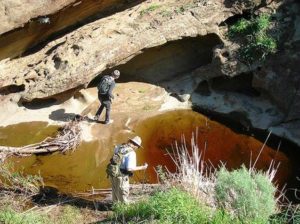
“People may be exposed to higher-than-normal levels of selenium at hazardous waste sites by swallowing soil or water, or by breathing dust,” says ATSDR. “The way that selenium can enter the body from a particular site depends on such factors as whether vegetables are grown in soil in which selenium from the site has been deposited, whether water at the site contains selenium and is able to flow into drinking water supplies, and whether selenium dust blows into the air.”
Several PAHs were detected above their BTVs in Brandeis-Bardin drainages down into the camp as well. “People living near waste sites containing PAHs may be exposed through contact with contaminated air, water, and soil,” reports ATSDR. “Studies of people show that individuals exposed by breathing or skin contact for long periods to mixtures that contain PAHs and other compounds can also develop cancer.”
The PAH naphthalene registered a substantial 5.4 times its SSFL BTV. “Naphthalene has caused cancer in animals,” according to ATSDR. “Naphthalene can become weakly attached to soil or pass through soil into underground water.”
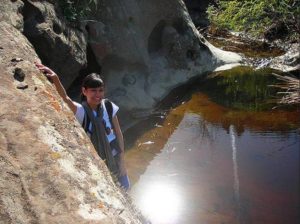
The PAH fluorine was detected at 5.7 times its BTV. It is described by the CDC as a “Pale-yellow to greenish gas with a pungent, irritating odor,” and is listed under “Immediately Dangerous to Life or Health Concentrations (IDLH).” Used as a chemical intermediate in a wide range of industrial uses, fluorine is sourced to formulate polyradicals for resins.
A wide range of herbicides and pesticides were used at Rocketdyne, many more than you would find on a typical lawn. That explains why the Area IV chemical background study identified so many and determined their BTVs. It might also explain how so much of these poisons ended up being detected by the short DOE report given by AJU to Jewish Journal then made public and analyzed by EnviroReporter.com. No less than a dozen of these substances exceeded their Area IV BTVs.
The insecticide Endosulfan I in Brandeis-Bardin measured a considerable 8.6 times its BTV. “How might I be exposed to endosulfan?” asks ATSDR in its ToxFAQs for Endosulfan page. “Touching contaminated soil or fruits or plants that have been sprayed with endosulfan will result in a small amount entering the body through the skin.”
Dieldrin is an insecticide that was banned for all uses by the EPA in 1987 yet is still found in Brandeis-Bardin dirt tested by the DOE at 3.1 times its background threshold value. “[D]ieldrin build up in the body after years of exposure and can affect the nervous system,” says ATSDR. “In animals, oral exposure to lower levels for a long period also affected the liver and decreased their ability to fight infections. We do not know whether aldrin or dieldrin affect the ability of people to fight disease.”
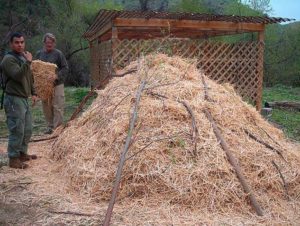
What is relevant to humans, at least the ones visiting, working, camping and living at Brandeis-Bardin is that Rabbi Strear and American Jewish University had already claimed “that there is no risk to human health in these sample results or in any other data collected from BBC to date.” Results from decades ago all the way through December 2016 from EPA, DOE, NASA and EnviroReporter.com may speak a very different story. Regardless of all these data showing toxic problems oozing from SSFL, the Obama Administration’s Department of Energy parting shot made clear in the first week of 2017 that it didn’t want any cleanup of Area IV at all.
Pollution Solution
DOE’s public policy line was different three years prior. “Let’s clean up to background,” said John Jones, federal project director for the DOE in Area IV, before a meeting of the SSFL Workgroup February 5, 2014. Jones told the audience that the agency was committed to the AOC it signed because, quoting another DOE official, “At the end of the day…it’s the right thing to do.”
Read more at BRANDEIS-BARDIN’S TOXIC DENIAL INVESTIGATION
Photos, videos, reports, figures, tests, data and special analysis
Jones’ words were well received. Indeed over 3,700 public comments had been submitted in support of the AOC with only a handful opposed. Soon after, Jones wasn’t so vocal. KNBC‘s Joel Grover filmed Jones refusing to speak with him at an SSFL-related meeting in 2015.
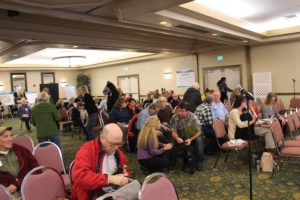
There is analysis of three options for cleanup that drastically allow more radiation and chemicals than DOE’s AOC allows. The first option would leave up to 39 percent of dirty dirt in place, the second allowing 91 percent of the soil not cleaned up and the third possibility leaves up to an amazing 99 percent of the known contaminated land not remediated.
Community outrage was evident February 18 when the DOE held the first of two public meetings to take public comment. “You promised six years ago you would clean up the mess you made so that it would be like you never made it in the first place,” said Devyn Gortner of Teens Against Toxins at DOE’s meeting in Simi Valley. “The community has debunked every single one of your excuses as to why you cannot keep this promise.”
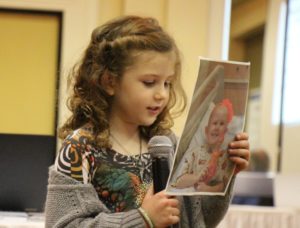
“My daughter was diagnosed, recently, with leukemia, a rare form called APL, which the doctors said it was directly related to an environmental issue,” said West Hills resident Mark Dow before the DOE panel in Simi Valley which included John Jones. A husband and father of two, Dow has lived about a mile from SSFL since 1996. “Our neighborhood has also had other cancers. We’ve had two children with brain cancer. We’ve had an adult die from brain cancer. We’ve also had two other cancers within our block. So when people say there is no direct correlation [to SSFL], I have to object.”
“We were there when the fires burned [2005] at that site and I could see the ashes coming into my yard and they looked extremely strange,” Dow continued. “They weren’t typical ashes and you could see it was muddy, gluey, particles coming into our neighborhood and it was appalling.”
Though much fewer in number, people against full cleanup of SSFL spoke out too. One was Nancy Kidd, an archaeologist who said at a DTSC meeting in 2013 that excavating “any dirt” at SSFL would result in Valley Fever region-wide. Kidd’s choice of words and their emphasis, repeated here in their entirety, shocked some in the crowd who knew their Holocaust history.
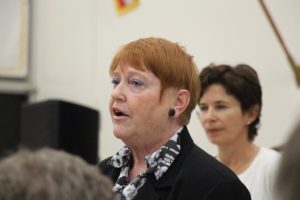
The crowd gasped at the hopefully inadvertent use of a term more appropriate to a Nazi like SS-Sturmbannführer (Major) Wernher von Braun back when he was an Adolf Hitler favorite. As outrageous as Kidd may have sounded, DOE’s conclusion that all this fuss about radiation and chemicals is specious may sound even worse. The department makes it abundantly clear that it doesn’t think there is anything to worry about, sound science be damned.
“Because there is little difference between those risks, there would also be little difference between the risks following cleanup under any of the soil remediation alternatives—risks in all cases would be close to those from exposure to background soil,” the DOE report reads suggesting there’s no need for any cleanup at all.
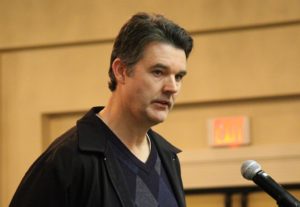
Not only does DOE boldly blind itself to all the foulness EPA found and figured the background levels for, it seems equally unable to comprehend that the department cannot unilaterally nix the cleanup. The AOC it signed in 2010 to clean up to background radiation and chemicals is a legally binding document. The AOCs for both the DOE and NASA make it explicitly clear that DTSC will determine cleanup decisions for both chemicals and radiation in the SSFL cleanup.
While the DOE states at the beginning of the draft EIS report that “DOE has no preferred alternative at this time,” it’s clear that the department does have a preference, and that is doing as little cleanup as possible. “The negative incremental risks calculated for the No Action Alternative imply that the concentrations of chemical and radionuclides in soil from site-related activities are less than the variability of background concentrations of those chemicals and radionuclides. Therefore, the risk of cancer incidence or death from chemicals and/or radionuclides in Area IV and the NBZ are comparable to or less than the risk determined for background soils.”
It goes without saying that if the DOE manages to get marching orders to do nothing in Area IV and the NBZ, nothing they will do. That leaves any possible contamination at Brandeis-Bardin, and its obvious source, left there forever. Nothing would please the polluters and their like-minded pals in the Trump Administration more.
The prospect of eternal pollution being the solution did not please the Ventura County Board of Supervisors in whose county the lab sits. At a March 7 meeting, the board made their unhappiness with the DOE clear with a 4-0 vote demanding adherence to the AOC. “Unfortunately, the EIS does not analyze cleaning the DOE site to the agreed upon stipulations in the 2010 Agreement on Consent,” the board’s letter to the DOE states. “Instead, hundreds of thousands of cubic yards of soil, some with known significant chemical and radiological contamination that would be covered by the AOC, are exempted from remediation.”
Read more at BRANDEIS-BARDIN’S TOXIC DENIAL INVESTIGATION
Photos, videos, reports, figures, tests, data and special analysis
“They have not done an analysis of cleaning up to background,” Supervisor Linda Parks said of the DOE at the board meeting, “something that they have a legal binding agreement to do so. If you look at the document, they have excluded somewhere in the neighborhood of 300,000 cubic feet to half a million cubic feet of soil from even the consideration of remediation.” Supervisor Steve Bennett concurred adding, “[T]his backsliding after all of this work and all of these agreements … is not appropriate or good government policy in terms of following through on commitments.”
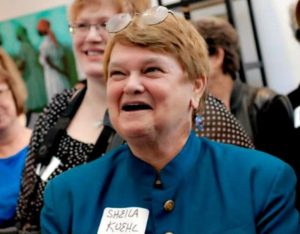
“This site has been a little unusual, actually, even compared to our other toxic sites in the county, because the federal government is so implicit in keeping this a dirty site and keeping it from being cleaned up, in not just dragging their heels, but in creating documents that lowball the danger, that lowball the health effects,” Kuehl declared to a room packed with appreciative pro-cleanup supporters. “Well, I believe in a cancer cluster when I see one, and I know what’s going on in these neighborhoods and what has been. If you see the film that was made about this site, and you see the workers given plastic aprons to go in and clean up a nuclear meltdown, or you see them shooting rifles at barrels of radioactive materials to set them on fire, and you watch this radiated material rising up into the air and spreading over miles of this area, and you think, well, you know, in the old days, they would claim, ‘Oh we didn’t know what we were doing, or we did and we didn’t care.’ But to say in the 21st Century ‘we know and we don’t care’ is really inexcusable.”












Have there been any reports of children getting cancer who have attended the camp
OPEN LETTER – “Are Jews at Brandeis-Bardin immune to radiation and chemicals?”
[Published on EnviroReporter.com in comments for “Brandeis-Bardin’s Toxic Denial” 2017 exposé at https://www.enviroreporter.com/2017/04/brandeis-bardins-toxic-denial/all/1/]
To: Ms. Rachel Levin, contributor to the New York Times Travel section
via http://byrachellevin.com/
From: Michael Collins, EnviroReporter.com
Regarding: New York Times September 18, 2019 Travel section article “Jewish Summer Camp With Campfires, Crafts and No Lights Out” by Rachel Levin at https://www.nytimes.com/2019/09/18/travel/jewish-adult-summer-camp.html
Ms. Levin,
Your article on the Jewish camp at Brandeis-Bardin in Simi Valley, California, would have been better informed if you had noted that “fission products” and radionuclides “used in reactor control rods” have been found at Brandeis-Bardin according to U.S. Department of Energy (DOE) reports. DOE operated above and bordering the camp at the heavily polluted Santa Susana Field Laboratory (SSFL) which experienced three partial nuclear meltdowns.
Perhaps you should have told your readers that 600 acres of SSFL drain into Brandeis-Bardin where elevated levels of radionuclides have been found in the soil, surface water and subsurface water including Strontium-90, Plutonium-239/240, Uranium-238 and beta radiation.
Your piece might have been more informative, and accurate, if you let your readers know that SSFL owner Boeing paid off Brandeis-Bardin $3.2 million for polluting its land in the late 1990s and bought much of the contaminated border property from the camp to serve as a new “Northern Buffer Zone.”
Jews, and other New York Times readers, might have been better served being informed that SSFL was first started to test Nazi war criminal and SS officer Wernher von Braun’s V-2 war rockets, the production of which cost 20,000 Mittelbau-Dora concentration camp inmates their lives with 9,000 dying from exhaustion alone. About 350 of these Nazi slaves were hanged, including 200 for sabotage, with the remainder shot or dying from disease and starvation.
Our online news organization’s website EnviroReporter.com, KNBC‘s I-Team and Jewish Journal have covered the contamination problems at the camp yet you and the New York Times fail to even allude to them.
A correction at the end of the piece confirms that Brandeis-Bardin’s name was misspelled in the original copy. That suggests that not a lot of fact-checking was done for this feel good travel piece that unfortunately forgot the meltdowns, Nazi rockets and contamination emanating from high above, and bordering the Jewish camp.
Michael Collins
EnviroReporter.com
Interesting new 2018 data in the Northern Buffer Zone that drains into the American Jewish University’s Brandeis-Bardin Campus.
https://www.dtsc-ssfl.com/files/lib_rcra_groundwater/quarterly_an_gw_repo/quarterly/68374_2018_Q3_Groundwater_Level_Monitoring_Report.pdf
Wells RD 33 A and C were found “Tampered With” yet in the polluters technical memorandum they are marked as non-detect.
https://www.dtsc-ssfl.com/files/lib_rcra_groundwater/interimmeasures/correspondence/68375_DOE_GWIM_Status_Tech_Memo_11-10-18.pdf
I guess that’s one way to cancel out “True Findings” or the other way is blatantly saying in the report that they are “False Positives” or “Anomalies” when Radioactivity (Strontium 90) was found in well RD-59 A and C
https://www.dtsc-ssfl.com/files/lib_rcra_groundwater/quarterly_an_gw_repo/quarterly/68374_2018_Q3_Groundwater_Level_Monitoring_Report.pdf
We NEED Independent Testing.
We NEED offsite Testing.
To ensure the safety of the surrounding communities.
Former Los Angeles Times environmental journalist Deborah Schoch has a comprehensive piece on Brandeis-Bardin’s contamination woes in a new NBC4 I-Team exclusive entitled Popular Kids’ Camp: Scientists Raise New Safety Concerns – Top scientists raise questions about a nearby former nuclear testing site and whether it poses risks to campers
Schoch’s exposé is a real eye-opener and seeks the opinions of expert scientists about whether the Jewish camp is safe for the thousands of children, and adults, who attend it each year to be part of Camp Alonim. The scientists are concerned about kids eating food grown in Brandeis-Bardin’s considerable vegetable gardens and orchard trees, especially since the officials of American Jewish University, which owns the camp, have consistently denied any such consumption:
“Most definitely there were gardens, and the kids would pick the produce, and it was cooked for dinner,” said Rabbi Laurie Hahn Tapper, who directed the Brandeis Camp Institute summer program from 2005 to 2007.
There are also concerns about missing data in environmental tests of the land as well as finding that:
Test results cited by the camp and state regulators are either too old or too inconclusive to definitely say whether children are safe from contamination from the Field Lab, several scientists said.
A 2016 study paid for by the camp’s owner, to investigate concerns about contamination, is flawed, according to UC Irvine public health professor Oladele Ogunseitan.
Schoch’s tenacity is why we are even able to read this fine reportage. Jewish Journal‘s new editor told her he would not be publishing the work. That didn’t stop Schoch. Now Jewish Journal‘s loss is NBC4‘s gain for which we owe a debt of gratitude. Work well done!
NBC4‘s I-Team has just come out with a blistering report with Scientists Question State Report on Camp Safety.
Seems some of the DTSC and AJU players in our piece could be in “collusion” says one of the I-Team’s whistleblowers. Here’s a snippet of the transcript of the dynamite video segment:
In the email to DTSC Project Team Manager Mark Malinowski, Rabbi Jay Strear of the American Jewish University writes “the KNBC report creates an urgent matter for us. I need to speak with you asap and am willing to come to Sacramento to meet with you {sic} any other needed DTSC officials.”
Strear goes on to attack the facts of the NBC4 reports, saying “we are in a highly compromised position and believe the only repair is through a definitive statement by DTSC substantiating your stated position that our property is safe.” He ends the email by saying, “Timing is most critical. We must produce something in the next 24 hours or we risk significant damage.”
The I-Team has done a superb and fearless job taking these people to task. EnviroReporter.com will be following up Brandeis-Bardin’s Toxic Denial in the near future and the I-Team’s piece will be part of the puzzle we’ve put together over the 13 years of our Brandeis-Bardin’s Toxic Denial INVESTIGATION.
As long as there is radioactive stuff on those 2 properties there is a possibility that there is a “continuing tort” against unsuspecting people who are “invited” to go on AJU’s property. Right now, BBI is actively seeking people to come to summer camp 2017.
I personally think Boeing and AJU are completely nuts to not remediate and protect BBI and the people continually being invited to go to BBI because of the risk of tort litigation by “the innocents”. This is even if the rest of the people living around SSFL have lost their right to sue Boeing because the statue of limitations has run out which is what several trial court judges said about 15 years ago.
A judge cannot impute knowledge about the “danger of exposure” to adult visitors or parents of child visitors to BBI, or new employees working at BBI, who live in Orange County, Bay Area or out of state.
Ignoring this information and not acting upon it will not only suggest the responsible parties’ culpability in the matter to most people, it will allow this scandal to continue and more people being exposed. That may cost AJU more than the millions it makes hosting these “innocents” in a place I wouldn’t walk my dog at.
Thank you commenters for your kind words and the detailed legal analysis.
Some related news: DTSC sent EnviroReporter.com its DTSC Comments on DOE’s DEIS two days ago and it is surprising in its insistence that DOE abide by its AOC. This strong stance has been greeted with optimism by people in the pro-cleanup community. DTSC’s objections, summarized in its own words, follow:
DTSC’s Key Concerns with DOE’s DEIS
1. The DEIS fails to only include alternatives that describe how DOE will comply with the 2010 Administrative Order on Consent (AOC). This is inconsistent with DOE’s earlier statement describing the cleanup’s purpose and need. Given this, we must reiterate that DTSC will hold DOE accountable for complying with the AOC.
2. The DEIS fails to provide sufficient information or analysis for DTSC to determine if any of the DEIS’ alternatives would comply with the AOC.
3. The DEIS describes at length a number of challenges to implementing of the AOC, however, it fails to take a hard look at how to overcome those challenges, including:
a. Inadequate survey, analysis, and use of agreed upon processes to identify potential options for acquiring clean backfill soil. DOE will use this soil to achieve
cleanup standards and restore the land’s natural contours following the removal of contaminated soil.
b. Conclusory statements about DOE’s inability to achieve the AOC’s preliminary cleanup standards, which are contained in the project’s “Look-Up Table” (LUT), without a thorough examination of available options for overcoming those challenges.
4. The DEIS assumes habitat for protected plants and animals is exempted from cleanup, but fails to explain how DOE proposes to utilize the AOC’s process of conferring with state and federal agencies on site-specific decisions to protect habitat.
5. The DEIS proposes to rely on the natural process of degradation (monitored natural attenuation) to reduce levels of certain contaminants to achieve cleanup standards, which may take decades and therefore violate the AOC’s prohibition on leaving contamination where it is found. Moreover, the DEIS fails to examine ways to accelerate the natural degradation process.
6. The DEIS assumes trucks will use 2019 air pollution control technology over the estimated 15-year timeline for the cleanup. This fails to account for the use of improved air pollution control technologies over time, which in turn undercuts the analysis needed of the project’s potential air pollution impacts.
Thank you for this amazing work that even I get. That’s great journalism. Thank you. The people are getting conned out of millions and getting no cleanup. It is an outrage.
If you hadn’t backed up this information I might not have believed it. Wow. Not good. One week since this came out and nothing from American Jewish University, Jewish Journal or Department of Energy? Their silence speaks volumes.
Putting the best possible spin on it, perhaps the good folks at Brandeis-Bardin Institute were simply unaware of the extent to which the toxic SSFL run-off could pollute their land. But now, Collins has documented it. BBI cannot blow this off, the health of way too many people is at stake.
A very complete and worrying description of contamination problems associated with SSFL and nearby lands. I would be concerned about residents and visitors who unknowingly come into contact with the airborne and waterborne effluent leaching from the hills and watersheds surrounding SSFL. Although the story mentions some warning signs on the Brandeis-Bardin property, I wonder if publicly accessible hiking trails in the area are similarly marked. And, of course, one wonders just how far the contaminates could migrate from the SSFL property. The very long half-life radionuclides could seep into groundwater supplies if given enough time. I lived within earshot of the SSFL Saturn IVB engine tests of the 1960s. But at the time, I had no idea of the trouble that would develop years later due to the research activities at SSFL. I hope that articles like this one will stir action within the community and from local governments to bring closure to the SSFL cleanup project. Thank you, Michael Collins, for writing this important investigative article.
To Michael Collins: I am beyond impressed with your very clear organization and explanation of many years of test results relating to the Brandeis-Bardin Institute’s property, and the implication that the parties involved don’t want to admit the degree of contamination that the tests show.
To the community of “Rocketdyne clean up activists” and visitor/camper/employees at Brandeis-Bardin Institute who may react to this Enviroreporter report with a question or a plea to the current decision makers for Brandeis-Bardin Institute “Why don’t you do something to make the clean-up of toxic and radioactive contamination happen” I hope to provide an answer as to why they most likely won’t.
The reason “they won’t do something” is in large part because the Board of Directors of American Jewish University, as the parent non-profit company to the non-profit owner of the Brandeis-Bardin property, are bound to a 1997 “Settlement and Release Agreement” between Boeing North America and Brandeis-Bardin Institute.
In essence, back in 1997 Brandeis-Bardin Institute’s decision makers decided release all of their past and future claims against Rocketdyne/Boeing and to put their faith in Federal, California and regional toxics regulatory agencies to “do the right thing” and decide upon the details of further clean-up of hazardous substances and radioactive substances on, under and near the Brandeis-Bardin Institute’s property.
Assuming that back in 1997 the Brandeis-Bardin Institute’s decision makers expectation was that the government agencies WOULD require additional soil and ground water clean-up by Boeing on and around Brandeis-Bardin Institute’s land, the sad fact is that 20 years later little has been done in terms of remediation improving the conditions of the Brandeis-Bardin Institute’s land or the Boeing land directly upstream from it or adjacent to it.
Assuming that back in 1997 the Brandeis-Bardin Institute’s decision makers expectation was that the government agencies WOULD require additional soil and ground water clean-up, the Settlement and Release Agreement they entered into with Boeing prevents Brandeis-Bardin Institute or its successor land owner from prosecuting any lawsuits NOW to try to force any such remediation.
One might say that given the wording of the Settlement and Release Agreement entered into by Brandeis-Bardin Institute in 1997, they shot themselves in the foot.
Back in 2015, when NBC Los Angeles was running its investigative news stories about Rocketdyne related contamination of Brandeis-Bardin Institute, NBC LA posted documents on its website which it believed supported its investigative news stories. The posted documents directly relate to the anguish exhibited today by “clean up Rocketdyne” activists and former Brandeis-Bardin Institute campers from around the state who are dismayed by the California Department of Toxic Substances Control and multiple Federal agencies desires to not order much if any remediation of radioactive and toxic substances on, under and near the Santa Susana Field Lab or Brandeis-Bardin Institute.
Among those documents posted online by NBC LA in 2015 was a letter dated October 23, 1997 from the late Judge Joseph A. Wapner to Brandeis-Bardin Institute’s lawyer Barry I. Goldman, enclosing the Settlement and Release Agreement with Boeing North America signed by Judge Wapner in his capacity as President of the Brandeis-Bardin Institute (“BBI”). In the letter Judge Wapner wrote to Mr. Goldman “Enclosed please find the original Settlement and Release Agreement signed by me as President of the Brandeis-Bardin Institute. I certainly hope this matter will be concluded soon. I know that you are doing everything in your power toward that end for which I sincerely thank you.”
The copy of that letter obtained by NBC LA showed a “cc” to Dr. Alvin Mars, the then Executive Vice President of Brandeis-Bardin Institute. In the style of secretaries in the 1990’s the “cc” to Dr. Alvin Mars had a little check mark next to it on the letter posted online by NBC LA, showing that the particular copy of the letter was the copy physically sent to Dr. Mars by Judge Wapner’s secretary. As a result one can conclude the copy of the letter and its attachment obtained by NBC LA has an appearance of authenticity because it likely came from (1) Dr. Mar’s file on the Rocketdyne/Boeing litigation, (2) a file maintained at the offices of Brandeis-Bardin Institute or (3) a file maintained by a person or entity who was authorized to receive a copy under that Settlement and Release Agreement’s terms.
To my knowledge, no copy of the “counterpart” of that Settlement and Release Agreement signed by Boeing North America (“BNA”) as corporate successor-by-merger to Rocketdyne, Inc. has been published by any media source.
From the text of that Settlement and Release Agreement attached to the letter described above it is fairly clear that neither Brandeis-Bardin Institute nor Boeing North America intended the text of that Settlement and Release Agreement be made public. All that Brandeis-Bardin Institute and Boeing North America intended the public see would be a one page “Dismissal With Prejudice” of the U.S. District Court case captioned The Brandeis-Bardin Institute v. Rocketdyne, Inc. et al. Case No. CV-95-8316 ABC (RMCx) signed by Brandeis-Bardin Institute’s lawyer. That practice of filing a one page dismissal of a lawsuit with the U.S. District Court without court-filing of the parties’ actual Settlement and Release Agreement is and has been very common for decades.
However, given the veneer of authentication of the version of the 1997 Settlement and Release Agreement signed by Brandeis-Bardin Institute in the late Judge Wapner’s letter described above, it is worth looking at the text of that Settlement and Release Agreement to understand the rights (or lack thereof) of Brandeis-Bardin Institute and the American Jewish University subsidiary which owns the Brandeis-Bardin Institute land today.
As a result readers should direct their attention to the that 1997 Settlement and Release Agreement, quoted below, and showing that Brandeis-Bardin Institute gave Boeing North America the customary ironclad release of known and unknown claims arising out of known and unknown facts related to the general subject of the lawsuit. In that Settlement and Release Agreement text “BBI” means Brandeis-Bardin Institute and its subsidiaries, and its successor entities and their subsidiaries and “BNA” means Boeing North America and its predecessor owners of the Santa Susana Field Lab, as well as their subsidiaries and successors in ownership or operation of the Field Lab.
The only comfort the release paragraphs in that Settlement and Release Agreement provide is that Brandeis-Bardin Institute did not purport to release claims held by “other people” who attended events at the property or who camped or ate food grown at the property.
That Settlement and Release Agreement does not describe, in any detail, the hazardous or radioactive substances found or alleged to be found, or not found, on any part of Brandeis-Bardin Institute’s property, including the part deeded over to a Boeing North America subsidiary in early 1998 as part of the implementation of the settlement.
Settlement and Release Agreement Section III Paragraph 1 provides: “General Release. BBI hereby releases and forever discharges BNA of and from any and all claims of any kind or nature, under any theory, whether legal, equitable or other, under the law, either common, constitutional, statutory, regulatory or other, of any jurisdiction, foreign or domestic, whether such claims are known or unknown, suspected or unsuspected [sic], including claims that BBI has brought or could have brought, which now exist or in the future may exist, arising out of or in any way related to events or matters referred to or which could have been referred to directly or indirectly in the Action [the Federal court case], including but not limited to, claims relating to hazardous substances at or emanating from the BBI site and the Field Lab.”
Settlement and Release Agreement Section III Paragraph 2 provides: “Waiver Under California Civil Code 1542. It is understood that 1542 of the Civil Code of California provides as follows: “A GENERAL RELEASE DOES NOT EXTEND TO CLAIMS THE CREDITOR DOES NOT KNOW OR SUSPECT TO EXIST IN HIS FAVOR AT THE TIME OF EXECUTING THE RELEASE, WHICH IF KNOWN BY HIM MUST HAVE MATERIALLY AFFECTED HIS SETTLEMENT WITH THE DEBTOR.” BBI expressly waives and releases any right or benefit which it has or may have under 1542 of the Civil Code of the State of California, to the extent it may waive all such rights and benefits pertaining to the matters released herein. In connection with such waiver and relinquishment, BBI acknowledges that it is aware that it may hereafter discover claims presently unknown or unsuspected, or facts in addition to or different from those which it now has or believes to be true, with respect to matters released herein. Nevertheless it is the intention of BBI, through this Agreement, and with the advice of counsel, fully, finally and forever to settle and release all such matters, and all claims relevant thereto, which do now exist, may exist or heretofore have existed between BBI and BNA. In furtherance of such intention, the release herein given shall be and remain in effect as a full and complete release of such matters notwithstanding the discovery or existence of any such additional different claims or facts relative thereto.”
The 1997 Release and Settlement Agreement DOE contain “custom drafted promises” between Brandeis-Bardin Institute and Boeing North America concerning remediation and non-remediation of hazardous substances found on the Brandeis-Bardin Institute property after the settlement went into effect. Those custom drafted provisions are found at Article III, Section 7 (page 8) of that Settlement and Release Agreement. Those paragraphs generally leave decision making about remediation to “regulatory agencies”, cutting Brandeis-Bardin Institute out of the decision-making process:
Settlement and Release Agreement Section III Paragraph 7a: “Remediation of Hazardous Substances a. BNA shall continue to investigate and remediate under the direction of regulatory agencies the hazardous substances emanating from the Field Lab. BBI shall fully cooperate with BNA, giving BNA access to the BBI Site, in connection with BNA’s investigation and remediation under the direction of the regulatory agencies of hazardous substances on the BBI Site emanating from the Field Lab. The scope of BNA’s investigation and remediation of hazardous substances shall be determined by the regulatory agencies, and not by BBI. BNA shall be responsible for remediation of the Parcels required by the regulatory agencies…”
To the public that Section III, Paragraph 7a is the most important provision in the Settlement and Release Agreement. In layman’s language, Brandeis-Bardin Institute promised not to demand any clean-up of hazardous substances (by definition in the Agreement including radioactive substances) on the Field Lab or on Brandeis-Bardin Institute’s remaining property other than clean-up required by “regulatory agencies” which by definition in Article I, Section 3 did NOT include Ventura County or any city.
As a result of that Settlement Agreement’s text at Section III Paragraph 7a, if the regulatory agencies do not require remediation to background level, Brandeis-Bardin Institute is stuck with that decision as to its own property and as to the Field Lab property adjoining it. If the regulatory agencies only require 39% of the hazardous or radioactive substances, Brandies Bardin Institute is stuck with that decision. The only power Brandeis-Bardin Institute still has, under that Settlement Agreement, is to do its own elective remediation of its own property after the regulatory agencies have relieved Boeing North America and its affiliates from any further remediation obligation.
Settlement and Release Agreement Section III Paragraph 7b provides: “b. Before selling, leasing, or otherwise conveying an interest in the BBI Site or any part thereof, BBI (i)shall provide a copy of this Agreement and make full disclosure of BBI’s obligation to cooperate fully with BNA, including giving BNA access to the BBI Site, in connection with BNA’s investigation and remediation under the direction of the regulatory agencies of hazardous substances on the BBI Site emanating from the Field Lab, (ii) shall obtain the written covenant from all persons acquiring an interest in the BBI Site or any part thereof in the form attached hereto as Exhibit C, and (iii) shall forward such covenant to BNA within five (5) days.”
In effect, Exhibit C was to be a binding admission by Brandeis-Bardin Institute as to the implied risks presented by its real estate being located adjacent to the Santa Susana Field Lab.
Unfortunately, the version of the Release and Settlement Agreement which Judge Wapner signed as President of Brandeis-Bardin Institute, and which NBC LA posted online, did not have Exhibit “C” attached. That is not unusual. Officers of corporations typically leave it to their company’s lawyers to approve the wording of exhibits and attach them to the “official” copies of settlement agreements. No other copies of the final version of Exhibit “C”, approved by the lawyers for Brandeis-Bardin Institute and Boeing North America, has surfaced in the press.
If Brandeis-Bardin Institute actually fulfilled its contractual promise to Boeing North America in that Settlement and Release Agreement’s Section III, Paragraph 7b quoted above, language mirroring the missing Exhibit “C” should have been signed by the lender under any deeds of trust recorded with the approval of Brandeis-Bardin Institute in connection with its borrowing against the BBI Site prior to or after American Jewish University’s acquisition of control of BBI. A document mirroring the text of Exhibit “C” should have been signed by any recipient/grantee of easements over the BBI Site, such as those which the BBI Site property owner granted to neighboring residential real estate developers, utility companies or the City of Simi Valley. The text of Exhibit “C” should have been included in one of the documents under which the BBI Site was deeded to a subsidiary of American Jewish University.
Brandeis-Bardin Institute’s “admission” in Exhibit “C”, or in documents quoting Exhibit “C” would be of great interest to any individual claiming that they or American Jewish University had a moral, ethical or legal obligation to disclose hazardous substances health risks associated with humans physically being on the BBI Site for any extended period of time. Documents with the Exhibit “C” wording may or may not have been filed with the Ventura County Recorder, because that Settlement and Release Agreement does not require that such a recording be made. As far as I know, no member of the press has publicized Exhibit “C” or a similar document pertaining to the parts of the BBI Site which Brandeis-Bardin Institute, American Jewish University, or their land-owning subsidiary which was recorded in those Ventura County Official Records in 1998 or later.
Other the requirement that Brandeis-Bardin Institute make an Exhibit “C” written disclosure to any legal person obtaining an interest in the BBI Site, the Release and Settlement Agreement between Brandeis-Bardin Institute and Boeing North America contains a broad non-disclosure agreement about that Settlement Agreement binding on Brandeis-Bardin Institute and, through a provision not quoted below, its subsidiaries, affiliates and successors:
Settlement and Release Agreement page 13, Article III, Section 18: “Non-Disclosure. The parties agree not to disclose in any way the terms or conditions of this Agreement to any person other than their counsel, auditors, insurance carriers, lenders, officers and directors, each of whom shall be informed of, and bound by, the confidentiality terms of this Agreement, except in response to a lawful subpoena or other lawful process or as may be required by an independent auditor, or as part of an effort to enforce the terms of this Agreement. In the event that a party believes that disclosure is otherwise required by law or is necessary to enforce this Agreement, it shall give prompt written notice via overnight delivery to the other parties to this Agreement prior to disclosing such information….Said notice shall set forth all of the information which the party to this Agreement proposes to disclose, the statute or other legal authority purportedly requiring disclosure, and the circumstances pursuant to which disclosure is to be made. If the party providing notice to the other party receives no notice within ten (10) days that the other party intends to seek to prevent disclosure, it may produce this Agreement…:
Since the counterpart of that Settlement and Release Agreement signed by Boeing North America has not publicly surfaced, and since the content of Exhibit “C” has not become public, one cannot say with 100% certainty that the Settlement and Release Agreement signed by the late Judge Wapner in October 1997 and posted online by NBC LA is the final version of the document. At the very least litigation and toxics lawyers would say that the document’s content looks like one which would have met with the approval of Boeing’s lawyers in 1997 as being a “customary” form of settlement agreement relating to hazardous materials contaminated properties in California.
The text of that Settlement and Release Agreement does NOT bluntly require that Brandeis-Bardin Institute (or its successor land owners) not make public comment about hazardous substances or radioactive substances found on, under or near the Brandeis-Bardin Institute at any point in time before or after the settlement. The text of that Settlement and Release Agreement does NOT bluntly forbid Brandeis-Bardin Institute from “warning” people participating in activities on its property, camping or living there, about the past or current status of hazards on the Brandeis-Bardin Institute property (the “BBI Site” referred to in the Settlement Agreement) or the Santa Susana Field Lab/Rocketdyne property.
However, on a purely investment-minded level there was and still is little benefit to the owners of the Brandeis-Bardin Institute land in Simi Valley to besmirch the physical condition of their property or property owned by others next door, because Brandeis-Bardin Institute has a history of selling a part of its property for office/warehouse land development and it is conceivable that in the future the American Jewish University could decide to have its subsidiary which owns the Brandeis-Bardin Institute land sell parts of its remaining land for residential development. In that sense, it is in AJU’s economic interest that the Federal, California and regional agencies involved in investigating the history of Rocketdyne aka Santa Susana Field lab find that no further clean-up or protective land use regulations are required.